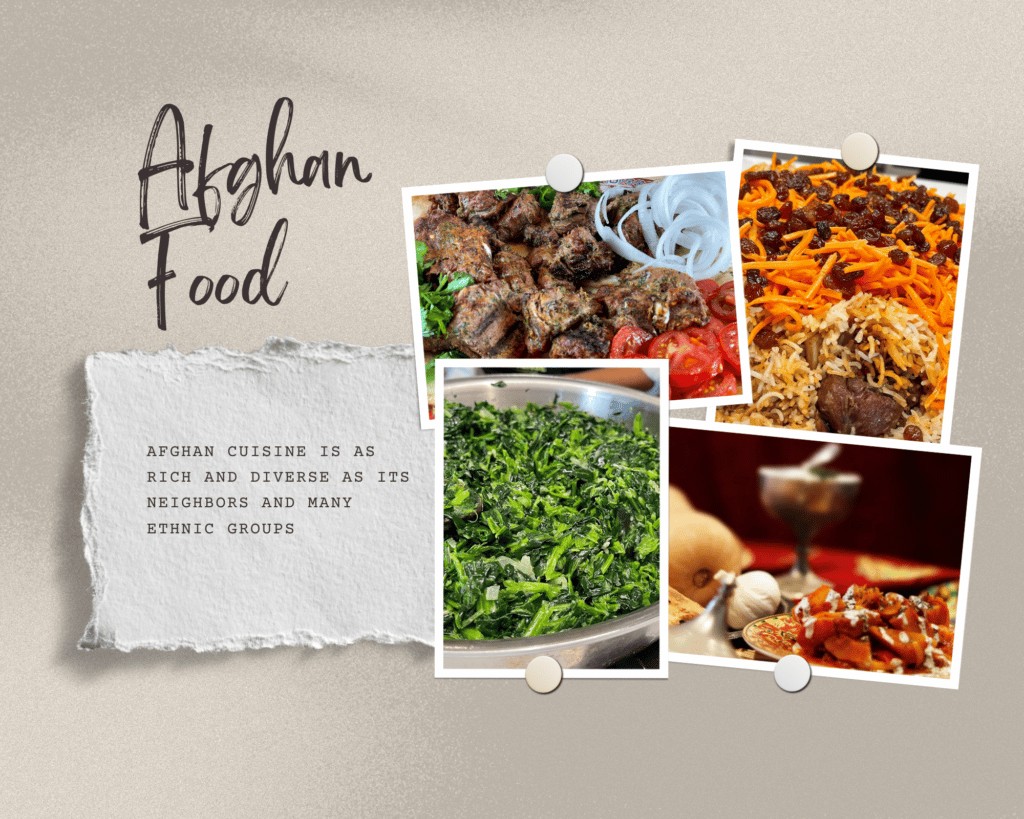Afghan cuisine is a tapestry woven from the threads of history, culture, and geography. It’s a source of immense pride for Afghans, reflecting a rich heritage and world-renowned hospitality. While some might perceive Afghan food as heavily influenced by its neighbors, the truth is more nuanced. The cuisine boasts a unique identity, drawing inspiration from various regions while maintaining its distinct character.
A Crossroads of Culinary Influences
Afghanistan’s strategic location along the ancient Silk Road has made it a melting pot of cultures and flavors. Situated at the crossroads of Asia, India, the Mediterranean, and Eastern Africa, Afghan cuisine reflects the culinary traditions of these diverse regions. This exchange of ingredients and techniques has resulted in a vibrant and complex culinary landscape.
 Afghan Food Collage
Afghan Food Collage
Internally, Afghanistan’s diverse ethnic groups – Hazara, Pashtun, Tajik, Uzbek, AImaq, Turkmen, Baloch, and Sadat – each contribute their unique culinary traditions to the national cuisine. This diversity manifests in regional variations of dishes and the use of different ingredients and cooking techniques. For instance, the similarities between Uzbek Pulao and the Afghan national dish, Kabuli Pulao, highlight the cross-cultural influences at play. The dumpling culture evident in Tajik cuisine also mirrors that found in Afghan Mantu.
Dispelling the “Spicy” Myth
A common misconception is that all food from “brown-skinned countries” is inherently spicy. This is a gross generalization, and it certainly doesn’t apply to Afghan food. While some Afghans enjoy spicy food and incorporate chilies into their dishes, the cuisine is not defined by its heat.
Afghan cuisine possesses its own distinct spice culture. Take, for example, char masala, a spice blend commonly used in Afghan cooking. The term “masala” might evoke associations with Indian cuisine, suggesting a connection. However, unlike garam masala, char masala typically excludes chili powder, highlighting a key difference.
The increased use of chilies in some Afghan cooking may be a more recent development. During periods of conflict, many Afghans sought refuge in Pakistan, where they developed a taste for the fiery flavors of Pakistani cuisine. Now, green sauce and other Afghan dishes often have chilies incorporated into them.
The Importance of Rice in Afghan Cuisine
Rice is a staple food in Afghanistan, forming the cornerstone of almost every meal. The varieties of rice dishes are seemingly endless, each with its unique flavor profile and preparation method. Kabuli Pulao, a savory rice dish with lamb, carrots, and raisins, holds the distinction of being the national dish. Other popular rice dishes include sabzi pulao (spinach rice), narenj pulao (orange-flavored rice), and mandi pulao.
Mastering the art of cooking Afghan rice, particularly challow (plain white rice), can be a rewarding experience.
Beyond Kebabs: Unique and Exciting Afghan Dishes
While Afghan kebabs are undeniably delicious, Afghan cuisine offers a much wider range of culinary delights. Qurut, for example, is a unique and intriguing ingredient.
Qurut is made from the whey of yogurt. The process involves extracting all the liquid from sour yogurt and then completely dehydrating the remaining solids. The result is small, hard balls with a tangy and savory flavor. Qurut is a key ingredient in dishes like Afghan Qurooti (a savory bread pudding). Some cooks have even experimented with using it as a substitute for parmesan cheese in dishes like Afghan pizza.
Pumpkins also hold a special place in Afghan cuisine, but not in the form of sweet pumpkin pie. Instead, Afghans use pumpkins in savory dishes. Borani Kadoo (pumpkin with yogurt sauce) is a popular dish that showcases the versatility of this humble vegetable.
Balancing Rich Flavors with Fresh and Tangy Accompaniments
Afghan cuisine often features rich stews and flavorful kebabs, typically served with naan (bread). To balance these rich and carb-heavy dishes, Afghans often rely on fresh and tangy accompaniments.
Salata, a simple Afghan salad, provides a refreshing counterpoint to the heavier dishes. Instead of creamy dressings, salata consists of fresh vegetables seasoned with lemon juice and salt. Afghan chutneys and yogurt sauces also serve to cut through the richness of the main courses.
Afghan cuisine is an invitation to a culinary journey, offering a diverse range of flavors and textures that reflect the country’s rich history and cultural heritage. From flavorful rice dishes to unique ingredients like qurut and refreshing salads, there’s something to satisfy every palate.
